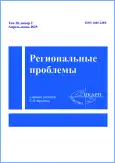Current state and prospective directions for the use of specially protected natural areas in the Jewish Autonomous region
- Authors: Zhuchkov D.1, Stelmakh E.1
-
Affiliations:
- Институт комплексного анализа региональных проблем ДВО РАН,
- Issue: Vol 28, No 2 (2025)
- Pages: 112-117
- Section: GEOECOLOGY
- URL: https://ogarev-online.ru/1605-220X/article/view/299539
- DOI: https://doi.org/10.31433/2618-9593-2025-28-2-112-117
- EDN: https://elibrary.ru/JUPSMR
- ID: 299539
Cite item
Full Text
Abstract
The project provides a brief overview of the current network of specially protected natural areas (SPNA) in the Jewish Autonomous region (JAR). The diversity of plant and animal species is emphasized. Particular attention is paid to the potential use of biological resources and territories for scientific, educational and recreational purposes. It is determined that the key factors for the development of recreational infrastructure within SPNA are the proximity to settlements and logistical accessibility, as well as the presence of well-maintained ecological trails and well-designed excursion routes, which form the regional modern tourism network. It is highlighted that tourism concepts and potential directions for the regional biodiversity integrated use are currently being developed in the JAR.
About the authors
D.V. Zhuchkov
Институт комплексного анализа региональных проблем ДВО РАН,
Email: dmitriy.zhuchkov.2000@mail.ru
ORCID iD: 0000-0001-7474-2910
Russian Federation, ул. Шолом-Алейхема 4, г. Биробиджан, 679016,
E.V. Stelmakh
Институт комплексного анализа региональных проблем ДВО РАН,
Author for correspondence.
Email: stelmahlena69@mail.ru
ORCID iD: 0000-0002-2060-8107
Russian Federation, ул. Шолом-Алейхема 4, г. Биробиджан, 679016,
References
- Gurevich V.S. Ourist Attraction as a Factor for Economy Diversifying at the Jewish Autonomous Region. Regional’nye problemy, 2024, vol. 27, no. 1, pp. 125–128. (In Russ.). doi: 10.31433/2618-9593-2024-27-1-112-115.
- Kalinin A.Yu. Optimization of the seismic research methodology in the South-East. Extended Abstract of Cand. Sci. (technical) Dissertation. Moscow, 2009. 22 p. (In Russ.).
- Klimina E.M., Ostroukhov A.V., Fetisov D.M., Lonkina E.S. Analysis of Landscape Structure of the Bastak Nature Reserve for Organizing of Geosystem Monitoring. Tikhookeanskaya geografiya, 2024, no. 1 (17), pp. 46–57. (In Russ.). doi: 10.35735/26870509_2024_17_4.
- Lonkina E.S., Rubtsova T.A. Ecological tourism in the Bastak Nature Reserve: the current state, in Aktual’nye problemy sovremennogo lesovodstva: vtorye mezhdunar. chteniya pamyati G.F. Morozova: k stoletiyu pamyati klassika russkogo lesovodstva 1920–2020 gg. (Actual problems of modern forestry: the second international readings in memory of G.F. Morozov: to the centenary of the memory of the classic of Russian forestry 1920-2020). Simferopol: Arial Publ., 2020, pp. 238–242. (In Russ.).
- Loshchilov K.S. Restoration of the Amur tiger population in the Jewish Autonomous Region, problems and solutions, in Sokhranenie populyatsii Amurskogo tigra: itogi, problemy i perspektivy: Mezhdunar. nauch.-prakt. simp. (Conservation of the Amur Tiger population: results, problems and prospects: International Scientific and Practical Symposium). Khabarovsk: Government of the Khabarovsk Territory, 2018, pp. 114–120. (In Russ.).
- Loshchilov K.S. «Dichun» Nature Reserve as a Promising Polygon for the Reintroduction of the Amur Goral (Nemorhaedus Caudatus) in the Northern Part of its Historical Range. Regional’nye problemy, 2024, vol. 27, no. 2, pp. 35–37. (In Russ.). doi: 10.31433/2618-9593-2024-27-2-35-37.
- Stelmach E.V. Landscape analysis of the territory and organization of environmental management of the Jewish Autonomous Region. Extended Abstract of Cand. Sci. (geogr.) Dissertation. Khabarovsk, 2005. 22 p. (In Russ.).
- Stelmach E.V., Shvedov V.G., Shevtsova L.V. Justification of the Organization of Pleistocene Tourism on the Territory of the Jewish Autonomous Region. Global’nyi nauchnyi potentsial, 2014, no. 6 (39), pp. 106–111. (In Russ.). EDN: SNRMPJ.
- Fetisov D.M., Ivakaev O.F., Yurkin M.V., Loshchilov K.S. Tourist zoning of the Jewish Autonomous Region. Regional’nye problemy, 2022, vol. 25, no. 4, pp. 54–66. (In Russ.). doi: 10.31433/2618-9593-2022-25-4-54-66.
Supplementary files









